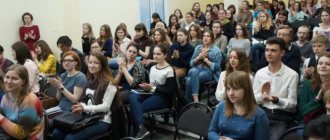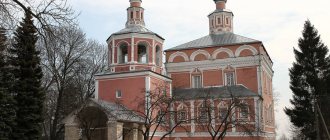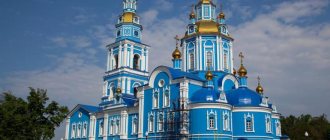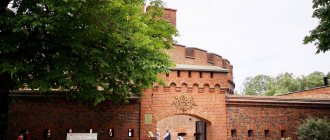On the banks of the Volga stands the city of Kimry, whose history began in the 16th century. For a long time it was considered the "shoe's edge." Cheap cattle were transported along the river past the town, which were bought for making shoes. During the reign of Peter I, the best shoemakers worked here. They made shoes for the Russian army. Thanks to the shoemaking industry, the city became rich, and the population began to lead a free lifestyle. It was at that moment that the phrase “drunk as a cobbler” appeared.
In 1915-1917 Kimry became a city. It had its own railway and a large shoe factory.
The name “Kimry” is an unusual word for Russian ears. The Chimera are ancient Celtic tribes. But they lived in the mountains of Wales and had never been to the Volga region. At the same time, there is a version that the Merya tribe lived on the site of the city of Kimry. These are Finno-Ugric tribes that came from the Trans-Urals and settled between the Oka and Volga rivers. And in the Celtic language, Merya and Cymry are the same word.
There are many interesting places around the city in the guide to the Tver region.
For ease of route planning, we have marked all the mentioned attractions on the city map:
Kimry Local Lore Museum
The building in which the entire history of the city of Kimry is concentrated was built in 1918 . The modern exhibition is presented in the form of collections of ancient clothing, furniture and household items.
This museum displays a huge collection of shoes for which this city has been famous for the last four centuries.
In the local history museum, tourists can see materials dedicated to the Great Patriotic War, which are presented here with photographs, documents, soldiers’ uniforms, and so on.
Tourists also have the opportunity to get acquainted with the flora and fauna of the area.
Location: Uritsky street - 8.
Churches and Temples
Temple of the Ascension
Address: Kalyaevsky lane, 2 Phone: +7 (48236) 31753 Website: vozneseniekimry.ru Opening hours: 09:00-14:00 Mon-Thu, 09:00-19:00 Fri-Sun, 14:00 - 16:00 break
The bell tower of the temple is visible from almost anywhere in the city. It was built in 1813 to replace two burnt wooden churches. Since then, it has undergone alterations, but has retained its general appearance.
The temple was erected at the expense of parishioners and merchants the Bashilovs. Thanks to the merchants, the refectory in the temple was later expanded, decorations were added, an iconostasis was installed, and the bell tower was reconstructed. After their death, the brothers bequeathed funds for the maintenance of the temple.
For a long time, a document from the 17th century was kept in the temple. It was signed by Tsars Ivan and Peter and issued to the boyar Saltykov. But at the beginning of this century the letter was transferred to the Tver museums.
In addition to the diploma, the church kept a silver cross of Countess Samoilova, an icon of Dmitry of Solon, an image of the Savior and the Sign of the Mother of God.
During the Soviet government, the temple was seized and used as a warehouse for Kimrotorg. The status of the temple was returned only in the early 90s.
Transfiguration Cathedral
Address: st. Uritskogo, 65 Phone: +7 (48236) 31970 Website: kimry-sobor.ru Opening hours: 08:00-12:00 Mon-Fri, 07:30-19:00 Sat-Sun
Construction of the temple began in 1902 and was completed in 1911. During this period, they did not have time to build the stone bell tower, and after the revolution, the Soviet authorities forbade its completion. In 1927, a document was signed on the closure of the temple. But on the first attempt, the authorities failed to describe the property. On the day of closure, parishioners surrounded the church and did not let officials in. They turned to the police for help. After the arrest of the instigators, the temple was described and closed.
At first, the building was used to house artisans, but then they began to store grain there.
During the Great Patriotic War, the church made a tangible contribution to the victory, which allowed parishioners to visit it after the victory over the Nazis.
Museum of reptiles
An attraction of this kind has a very interesting history. Among local legends and tales, there is a legend that the Serpent Gorynych once lived in these places. On the territory of the modern city, according to the same legend, there was a village called Gadov, this name was due to the fact that the area was literally swarming with all kinds of snakes.
And now tourists can look at snakes made of wood, iron, fabric and other materials. The museum even displays images of fabulous and mythical reptiles.
Within the walls of the museum, tourists are offered a tasting of alcoholic drinks made from snake venom.
Prince Staritsky
For special military merits under Ivan IV, the village of Kimry was granted ownership to the voivode, boyar, appanage prince Vladimir Andreevich Staritsky, whose squad, along with other regiments, dealt the main blow during the capture of Kazan.
It is worth drawing your attention to the fact that Kimrami was given “for the sovereign’s service,” as a rule, to royal relatives. For example, Prince Staritsky was a cousin of Ivan the Terrible. By the way, the prince’s father owned the principality and the city of Staritsa, and their surname came from there. In 1553, Ivan IV became seriously ill and, expecting his death, refused the throne to his infant son. Some of the boyars, including Staritsky, who had his own views on the throne, refused to swear allegiance to the baby... True, later the prince swore allegiance, but... The recovered John would not have been the Terrible if he had forgiven such actions.
From the road, the prince was called to the sovereign in Aleksandrovskaya Sloboda, and on the way Malyuta Skuratov and Vasily Gryaznoe were already waiting for him, falsely accusing him of attempting to assassinate the tsar. The prince himself and his entire family were forced to take poison... Thus, the contender for the throne was eliminated.
From the documents in the central archive, the original letter of grant dated March 10, 1555, which mentioned Kimry, has been preserved. After the death of the prince, the village again acquired the status of a palace.
Transfiguration Cathedral
This religious center was built in the city of Kimry in 1911. The author of the project was the Russian architect F. Rybinsky.
The cathedral was built in the form of a three-altar, five-domed temple, decorated in the style of an ancient Russian church. up to 1,000 parishioners can attend the service . On the roof of the cathedral, tourists can see 5 tents installed on light drums.
During the Soviet period, the cathedral, like most religious centers in those days, was closed; a granary was located in its building. In 1996, the cathedral was reopened.
Location: Uritsky street - 65.
Countess Samoilova
The eldest daughter of Ekaterina Vasilievna from Count Vorontsov, Ekaterina, was married off in 1800 to Prince Pyotr Ivanovich Bagration, the hero of Suvorov’s campaigns in 1812. Their family life did not work out, and she actually spent all her time abroad, where she died in 1857. Her younger sister had one daughter, who later became famous thanks to her adventures - Countess Yulia Pavlovna Samoilova. In 1827, Samoilova, being the wife of the aide-de-camp, met the famous artist Karl Pavlovich Bryullov, playing a huge role in his life and work...
In 1832, Samoilova traveled to Italy, where Bryullov immortalized her image in the painting “The Last Day of Pompeii.” You can find her in the left corner of the canvas, in the image of a mother with two children. There are other paintings depicting Samoilova.
In 1846, the Countess remarried, choosing an unknown Italian singer as her life partner. This deprived her of the count's title, Russian citizenship and rights to real estate. She spent her old age near Paris, where she died in poverty in 1875. After a quick look at the biography of the owners of the Kimra sed, we will return to two of them, who played a certain role in the life of the village.
Kimry Drama Theater
In the city of Kimry in 1942, the talented Russian director A. M. Giatsintov founded a drama theater, of which he became the director. Initially the troupe consisted of only nine people.
Over the entire period of its existence, a huge number of different plays and performances were staged within the walls of the theater, in which talented actors played.
Location: Oktyabrskaya street.
Church of Our Lady of Jerusalem
Not far from the city of Kimry there is a three-altar church dedicated to the Virgin Mary, built of stone. This landmark appeared in 1825, it is made in the style of classicism.
The church has correct architectural details and proportions. During the period of Soviet rule, the building of this religious center was closed and was completely abandoned for almost 60 years. The church began to function again in the 1990s.
Location: Bely Gorodok village.
Attractions in the surrounding area
Zoocircus Kolkunovo
Address: Kimry district, Pleshkovo village Telephone: +7 (495) 7369486; +7 (916) 7369449 Website: kolkunovo.ru Opening hours: around the clock How to get there: from the city of Kimry, move 17 km towards the village of Pleshkovo. The complex is located at the exit of the village.
On the territory of the Kolkunovo complex there is a petting zoo with horses, ponies and other animals.
Adults can enjoy water sports, visit the sauna, and go fishing.
There are several houses available for accommodation with a capacity ranging from 2 people to 10.
UFO Park
Address: Pleshkovo village, Leninsky pr., 72/2 Telephone: +7 (495) 7369486 hours: 24 hours Cost: 550 rubles – complex ticket; 250 rubles – for children over 3 years old How to get there: from the city of Kimry, move 13 km towards the village of Pleshkovo
A large amusement park opened in the suburbs of Kimry in 2014. The territory has a variety of children's attractions, playgrounds, a rope park for adults and children, a swimming pool, and a zoo.
The zoo features domestic and exotic animals. The park occupies a large area, so many animals live in the forest in comfortable conditions.
The park is located on the shore of a pond where you can go fishing or swim on a catamaran.
You can relax after a walk in small cafes, which are evenly distributed throughout the complex.
Museum of reptiles
Address: Volzhsky village, st. Vostochnaya, 4A Phone: +7 (48236) 79348 Website: muzey.gadovo.ru Opening hours: 08:00-16:00 Tue-Fri, 11:00-16:00 Sat, Sun, Mon - closed How to get there : drive 30 km from the city of Kimry along the Kimry – Bely Gorodok highway
Volzhsky was formerly called Gadovo. According to one legend, this village is the birthplace of the fairy tale hero Zmey Gorynych. According to another version, there were always a large number of snakes in this village. But due to the dissonant name, in the 60s Gadovo was renamed Volzhsky.
Now the museum exhibits snakes made from a variety of materials. It is best to visit it with children. Various events are organized for them, they are told about the history of the region, about snakes and how to behave.
There is a Russian-style cafe in the museum building.
Church of Our Lady of Jerusalem
Address: Bely Gorodok village Phone: +7 (48236) 3-92-98 Website: hram-belogorodok.ru How to get there: follow the Kimry – Bely Gorodok highway 20 km
The history of the church is closely connected with the icon of the Mother of God of Jerusalem. According to legend, the miraculous icon was painted by the Evangelist Luke. The icon was kept near the right choir.
After the revolution, the temple was closed. In the 90s, a religious community was formed, which achieved the opening of the temple and the restoration of the church.
If you have not yet chosen where you will live and want to save money when booking, we recommend using the RoomGuru service. Firstly, it contains hotels, apartments and guest houses from many different booking systems, so you won’t miss out on a worthwhile option. Secondly, you can immediately compare prices for one place in different services and book where it is cheaper (this is not always Booking!).
District House of Crafts and Folklore
One of the most interesting and at the same time unique attractions of the city of Kimry is considered to be this unique house-museum, located in an old estate that once belonged to the Shkvarin family of entrepreneurs.
The house contains a rich collection of household items, utensils and furniture used by peasants. Tourists can also see a huge collection of ancient folk costumes and ritual dolls there.
Today, vacationers can try themselves as craftsmen in sewing toys, weaving, hand embroidery, carving and wood painting. Everyone can buy interesting souvenirs.
Location: Kirova street - 19.
Fadeev embankment
While walking along Kimry, you can go out to one of the main streets of the city, Fadeev embankment, and take a promenade along it.
The embankment is surrounded by an interesting landscape in the form of clearings overgrown with wheatgrass and burdocks, neighboring Soviet high-rise buildings and ancient houses made of brick or wood.
This place is a favorite among locals. The embankment received its name in the 1960s; before that time it had no name.
Monument to the Kimry Shoemaker
In 2014, in the very center of the city, on the territory located between the district and city administration buildings, a monument to the famous resident, the Kimry shoemaker, was erected. The author of this project was the sculptor Samvel Vardanyan.
The history of this monument appeared thanks to the initiative of local residents who wished to remember the history of their hometown and perpetuate the memory of shoemakers who in the past glorified this region.
It is noteworthy that this monument was created with funds provided by local entrepreneurs.
Location: Kirova street - 18.
Monument to the TU-124 aircraft
The decoration of the city of Kimry is the TU-124 aircraft mounted on a pedestal. Initially, they intended to open a cafe in the cabin of the aircraft; at one time they even planned to make a cinema there, but these projects were not implemented. The aircraft is periodically repainted and repaired.
Location: Kommunisticheskaya street - 2/5.
House of merchant V. D. Sobtsov
This landmark was built in 1895. The house was built in the style of late classicism and was considered at that time a modern and fashionable building.
The first floor was reserved for a shop where the goods of the merchant Sobtsov were sold; on the second floor he lived with his family.
Later, the trading house “E. Evreinov and Son” was located in this building; now the historical building is occupied by a sports bar and entertainment center.
The façade of the building is painted white and decorated with arched windows.
Location: Uritsky street - 5.
Countess Golovkina
After the death of boyar Saltykov, the village was owned by his relatives, and, in the end, it passed to the boyar’s granddaughter Ekaterina Ivanovna Romodanovskaya, by her husband Golovkina. Ekaterina Ivanovna was an educated lady, knew two languages, shone at assemblies, was known as Peter’s favorite... In 1722, she was married to Count Mikhail Gavrilovich Golovkin, the son of the State Chancellor of Russia, who was distantly related to Peter I.
Reliable sources say: Mikhail Gavrilovich Golovkin (1699-1755) - count, Russian diplomat, statesman - was sent abroad to study, and then in 1722 took the post of Russian ambassador in Berlin. After Anna Ioannovna's accession to the throne, he was appointed senator and placed in charge of the mint office and the monetary court. The Count enjoyed the exceptional trust and influence of Anna Leopoldovna, who appointed him to the newly created position of Vice-Chancellor of Internal Affairs. After a palace coup in 1741, Golovkin was sentenced to death, but it was replaced by exile to Yakutia, where he subsequently died. The village of Kimry was confiscated.
Countess Ekaterina Ivanovna begged the Empress to reconsider the case, but she promised to retain all the privileges of a state lady and estate if she abandoned her husband. The countess’s answer was as follows: “What do I need honors and riches when I cannot share them with my friend. I loved my husband in happiness, I love him in misfortune, and I ask for one favor, that I be inseparable from him.” Ekaterina Ivanovna went into exile, and after the death of her husband in 1755, she returned to Moscow. Her noble act, which anticipated the behavior of the wives of the Decembrists, aroused respect in society, including Catherine I. The Countess died in 1791, leaving no offspring.
Monument to V.I. Lenin
On Teatralnaya Square, tourists can see the monument to the leader of the world proletariat V.I. Lenin, which was erected in 1934. Earlier in 1912, a monument to the reforming emperor Alexander II was erected at the same place, which was later demolished.
The monument to Ilyich is made entirely of marble and stands on a granite pedestal. The leader's right hand is thrown forward, he is dressed in his famous three-piece suit. There are flower beds around the monument.
Location: October Square.
How Kimry became the capital of the shoe kingdom, and what remains of its former luxury today
Nowadays, Kimry makes a very depressing impression on the traveler. You can’t look at once beautiful buildings that are falling apart before your eyes without tears. When asked why this is happening, local authorities just shrug their shoulders: there is no money. Yes, when local budgets do not have enough funds to pay salaries to state employees, the necessary repairs of city infrastructure and maintenance of the social sphere, there is no time for restoration of ancient buildings, enough for people.
Mansion of the merchant Teplov (Kirova St., 5)
Kimry, which stands on the high Volga bank at the confluence of the Kimrka River with the Volga, was called Kimra in the old days. The Kimrka River divided the settlement into two parts: the central Trinity and the trans-river Voznesenskaya. Before the revolution, it was one of the richest villages in Russia, its appearance more reminiscent of a city, a major center of the leather and footwear industry.
The confluence of the Kimrka and the Volga and a view of the Voznesenskaya side
The first people appeared in these places about 12 thousand years ago. In the 10th-11th centuries, the Krivichi came here, who may have assimilated the Merians living here. In 1485, these lands, as part of the Grand Duchy of Tver, were annexed to the Moscow Principality.
The village of Kimra was first mentioned in the letter of Ivan the Terrible dated February 15, 1546. At that time it was under the jurisdiction of the order of the Grand Palace, i.e. was a palace official and complained to particularly distinguished civil servants. The owners of the village in the 16th-18th centuries were Staritsky Prince Vladimir Andreevich, Prince Fyodor Ivanovich Mstislavsky, Prince Alexey Mikhailovich Lvov, boyar Alexander Petrovich Saltykov, Countess Ekaterina Ivanovna Golovkina (nee Princess Romodanovskaya), Countess Anna Karlovna Vorontsova (nee Countess Skavronskaya).
Thanks to its advantageous position on the Volga, Kimry grew quickly. Even during the time of Ivan the Terrible, “not only from Pereslavl, but even from Smolensk,” peasants from the Pesnoshsky, Solovetsky, and Belozersky monasteries, came to trade in Kimry. By 1635, there were 104 households in Kimra.
Volga in Kimry. The bridge across the Volga was built in 1974-1978, its length is 905 m, width - 20 m, height - 15 m
Kimry and the surrounding area have long been famous for their tanning industry. At the beginning of the 18th century, Vasily Fedorovich Saltykov, who owned the village at that time, achieved the placement of part of the army orders in Kimry: Kimry peasants supplied shoes, leather uniforms and saddles for the needs of the army. The Kimryaks improved the boot: they put it on a hard sole and strengthened the back. Thanks to this order, the shoemaking industry in Kimry began to develop rapidly. According to the Swedish traveler Strolenberg, who visited these places in 1710, “In Kimry there are the best tailors and shoemakers, known throughout Russia.”
In the second half of the 18th century, Kimry became one of the largest centers of the Russian shoe industry. It was not without reason that they said that “the Russian army marched along the pavements of Paris in boots made in Kimry.” As a sign of gratitude for the supply of shoes to the army in 1812, Emperor Alexander I granted the village a battery of cannons, which were subsequently fired on holidays.
A.K. Vorontsova’s husband, Count Mikhail Illarionovich Vorontsov, played a major role in the development of the village. Thanks to him, trade began to actively develop in Kimry; stone shopping arcades were built on Cathedral Square. At the beginning of the 19th century, the Kimryaks also began to engage in the grain trade along the Volga and, having become rich from this, began to invest money in the shoemaking craft, thereby contributing to its further development.
In 1847, Countess Yulia Pavlovna Samoilova, the last owner of the village, who mostly lived abroad, sold the Kimry estate to the treasury. The Kimry peasants, together with the surrounding villages, took advantage of the situation and bought themselves with land and buildings for 495 thousand rubles (a considerable amount at that time) with an installment plan of 37 years and 6% per annum.
Kimri shoemakers and shoemakers were divided into two categories. The first category included the owners of large workshops. The second category consisted of village residents who sewed shoes at home and sold them at Saturday markets. A real “shoe kingdom” with an area of 1,500 square kilometers has formed around Kimry. In the 18th century, the shoe industry actively developed in Taldom, located not far from Kimry.
Illustrated map of European Russia, 1896. Kimry is marked with a cross. Source: retromap.ru
Shoes made by the Stolyarovs were very popular. The boots they made were highly praised at the World Exhibition in London in 1862. The issued diploma gave them the right to put a personal brand on the inside of the boot. In 1907, the Partnership of N.A. Stolyarov and his sons founded the Yakor shoe factory. In 1916, 200 thousand pairs of shoes were produced here.
Before the First World War, there were more than 16 thousand shoemakers in Kimry district and the adjacent volosts of Kashinsky and Kalyazinsky districts. The volume of products produced was amazing: about 2.5 million pairs of shoes per year! They said: “Kimryak makes boots from clay.” A unique collection of Kimry shoes from the 18th-19th centuries can be seen in the local local history museum.
Shoemaker at work. Exposition of the Kimry Museum of Local Lore. Photo from the museum website muzeykimry.ru
Kimry fairs were one of the largest in the Tver province. Up to 20 thousand people attended them every week. Of course, the most popular product was shoes. Usually it was sold in bulk to buyers - “burbots”, as they were called, who then resold it at a much higher price throughout Russia.
Market day, 1917-1930. Source: pastvu.com
Kimry owes its urban appearance to the great fire of 1859, in which almost all of the wooden buildings were destroyed. Emperor Alexander II ordered the allocation of 18 thousand rubles without repayment and a loan of 14 thousand for the restoration of the village. Insurance premiums amounted to 27 thousand rubles. Kimry received a regular development plan, although this was the privilege of the cities. However, the Kimryaks were in no hurry to change their status to urban ones, so as not to pay higher taxes compared to rural ones.
Panorama of the village of Kimry from the bell tower of the Trinity Cathedral, 1913-1917. Source: pastvu.com View from the bell tower of Trinity Church, 1900-1903. Source: pastvu.com
View from the bell tower of the Trinity Church on the Kimrka River, 1915-1938. Source: pastvu.com
Where the red and white building of the Kimry Ladies and Comedy Theater is now located, there used to be a cold, five-domed Intercession Cathedral. It was erected in 1816-1825 on the site of the baroque church of the same name, built by Italian architects, which burned down in a fire in 1807. Closer to the Kimrka River stood the winter single-domed Trinity Cathedral with a bell tower, built in 1829-1833. According to the authors of the publication “European Russia” in 1913, the Great Cathedral Square in Kimry could be an adornment of any provincial city, and even the capital.
Temple complex. Cathedral of the Intercession of the Blessed Virgin Mary and the Cathedral of the Life-Giving Trinity, 1903. Source: pastvu.com
Trinity and Intercession Cathedral, view from the Volga, 1867. Source: pastvu.com
The Intercession Cathedral was closed in 1930 and blown up in 1936. In its place, the Industrial Cooperation Club was erected, and in the 1980s, the current building of the Drama and Comedy Theater was erected. After its closure, Trinity Cathedral was used as a granary; in 1936 it was planned to be rebuilt as a museum, but in 1937 it was dismantled into bricks. Now in its place there are private residential buildings.
The Kimry Drama and Comedy Theater was formed in 1942 as a result of the merger of the evacuated Rzhev and Torzhok theaters
On the Ascension side there is the Church of the Ascension of the Lord. It was built in 1813 at the expense of parishioners and the Bashilov brothers, on the site of a wooden church that had previously stood here. It was closed in 1941, after which it housed an oil mill, then the warehouses of the Kimry Trading Society. In 1990, it was handed over to believers, and restoration began.
Church of the Ascension of the Lord and the Ascension part of Kimry
Three cathedrals created a beautiful perspective, marking the mouth of the Kimrka.
View from the bell tower of the Ascension Church on the city of Kimry. 1903 Photo by M. P. Dmitriev. Source: pastvu.com
In 1902, construction of the Transfiguration Cathedral began in Kimry, which was completed in 1911. It was closed in 1929, and the priests who served there were shot. The building of the former temple housed a handicraftsmen's club, then a granary. However, in 1947, at the request of believers, services there were resumed.
Transfiguration Cathedral in Kimry (Uritsky St., 65). Source: Wikipedia
In total, before the revolution, there were six Orthodox churches in Kimry, as well as the courtyard of the Ilinsky Holy Trinity Convent. Only two of them have survived to this day: the Transfiguration Cathedral and the Church of the Ascension of the Lord. The courtyard building has now been rebuilt and houses various institutions and shops.
On October 12, 1912, on Cathedral Square (now Teatralnaya Square), approximately where the flowerbed is now laid out, a monument to Emperor Alexander II was erected: Grand Duke Alexander Nikolaevich, the future Emperor Alexander II, visited Kimru in 1837.
Monument to Tsar the Liberator Alexander II, 1912. Source: pastvu.com
In 1914, on Cathedral Square, on the site of the dilapidated Vorontsov Gostiny Dvor, the New Gostiny Dvor was erected in a neo-Russian style, reminiscent of Moscow's Upper Trading Rows (GUM) in miniature. A little earlier, in 1909, brick shopping arcades were built on the site of the old shops.
New Gostiny Dvor and Trading Rows on Cathedral Square, 1914-1917. Source: pastvu.com
Alas, today all that remains of Gostiny Dvor and Trading Rows are ruins.
Ruins of Gostiny Dvor (before the collapse)
Ruins of Gostiny Dvor and Trading Rows (photo taken in 2014, before the collapse)
In 1890, the population of Kimry exceeded 6 thousand people, in 1916 - 20 thousand. The rich Kimryaks invited famous architects and built houses “like in the capitals.” Unlike the very poor peasants of the Tver province, they were wealthy people, dandies and generally lived in grand style. Perhaps this is where the famous saying comes from: “Drunk as a cobbler.”
Bolshaya Street (now Volodarsky Street), 1890-1908. Source: pastvu.com
Ilyinskaya Street (now Uritsky Street) near the houses of Naumov (No. 6) and Sobtsov (No. 5), 1914-1917. Source: pastvu.com
Troitskaya Street, 1890-1907. Source: pastvu.com
In March 1871, the Kimry Rural Public and Moshkin Brothers Bank was established in Kimry, which became the first rural bank in the Russian Empire. By 1916, two banks, a treasury, and a credit partnership operated in Kimry; there were 4 schools, 2 ministerial schools, 5 zemstvo schools; there were almshouses, a fire station, a power plant, a water supply system, a library-reading room, shelters, and a post office.
Kimry Trinity Temperance Society. Tea room. Corner of Konnaya and Ilyinskaya streets. 1906-1911. Source: pastvu.com
In 1900-1902, the Savelovskaya railway was built, connecting Moscow with the village of Savelovo located on the opposite bank of the Volga (now part of the city of Kimry). In 1915, railway workshops for the repair of rolling stock of narrow-gauge railways were opened in Savelovo.
Savelovo station, 1910-1917. The water tower was demolished in the 2000s, allegedly due to a crack in the brickwork, and the station building is upholstered in siding in the gray and red colors of Russian Railways. Source: pastvu.com
During the First World War, large manufacturers organized the Military-Industrial Committee in Kimry, which supplied shoes to the front. The city also organized a Committee for the construction of hospitals named after traders and industrialists of the village of Kimry, which was headed by Vasily Nikolaevich Serepyev, who provided his home for the hospital of the All-Russian Zemstvo Union.
Hospital of the All-Russian Zemstvo Union, 1915. Source: pastvu.com
On June 3 (16), 1917, the village of Kimry received the status of a city by decree of the Provisional Government.
During the Civil War, the Yakor factory continued to produce shoes, mainly of army type. During this time, 300 thousand pairs of shoes were manufactured. In 1923, for services to the Red Army, it was renamed “Red Star”. During the Great Patriotic War, Red Star produced 3 million pairs of shoes, including 1 million soldiers’ shoes. The famous tarpaulin boots were made, among other things, in Kimry.
The Soviet writer A.A. Fadeev was born in Kimry, the village of Pustomazovo near Kimry is the birthplace of aircraft designer A.N. Tupolev. The Kimrys also became famous for their original artists. Self-taught sculptor I.M. Abalyaev (1901-1941) created naive sculptures of small forms, many of which depict Kimry artisans. The works of the representative of naive art, Baba Lyuba - Lyubov Mikhailovna Maykova (1899-1998), fascinate with their images and colors. Their works can be seen in the Kimry Museum of Local Lore.
Currently, Kimry is a regional center in the Tver region with a population of less than 45 thousand inhabitants. The remains of the former luxury of the once richest village can be seen today.
Houses on Volodarskogo Street The building of the Public Bank (1912) and the main house of the city estate, 2nd floor. XIX century - Sobtsova gymnasium (Volodarsky St., 24, 26)
House in Art Nouveau style (now a post office, Volodarskogo St., 18) Former merchant club of A.N. Naumov (Uritskogo St., 4/6) and a house built in 1913 (Mayskaya Sq., 6/4) Houses along the street Kirov
Of course, it’s worth going to Kimry: the architecture of Kimry is an excellent example of provincial modernism. We must hurry to see what has not yet been destroyed by time and people.
House of the Luzhin brothers (photo from 2014, before restoration; Kirova St., 28a-b)
House of Doctor N.A. Zhardetsky (Kirova St., 3) House of Serepyev Merchants (Kirova St., 23)
But it’s just very sad that what was once the richest village has turned into a city whose name is associated more with devastation, drugs and crime. But this is a problem for our entire country...
© Website “On the Roads of the Middle Way”, 2009-2021. Copying and reprinting of any materials and photographs from the site anashina.com in electronic publications and printed publications is prohibited.
Monument to A. N. Tupolev
In 1979, a monument to the famous Soviet aircraft designer A.N. Tupolev was erected in the city of Kimry. Previously, a monument to I. V. Stalin already stood on this site, which was dismantled in 1962 (which is associated with the famous “Cult of Personality” of N. S. Khrushchev).
The author of this project was the Soviet sculptor Kh. Gevorkyan.
The bust of Tupolev is mounted on a pedestal, behind which there is a stele with an image of the first space satellite on it.
Location: May Square.
Prince Mstislavsky
In July 1591, Prince Fyodor Ivanovich Mstislavsky became the owner of Kimry, again for the sovereign's service. The son of Ivan the Terrible, Fyodor, granted Mstislavsky the “fur coat from the royal shoulder” and the suburb of Kashin with the district, which included Kimry. The prince received such significant gifts because he managed to distinguish himself in the defeat of the Crimean Khan Kazy Giray, who approached Moscow.
Who is Prince Mstislavsky? He was a descendant of the Grand Duke of Lithuania Gedemin. After the death of Tsar Fyodor Ioannovich, boyar Mstislavsky was named among the contenders for the throne. The prince died in 1622, childless... And again the Kimrys returned to the palace household.











